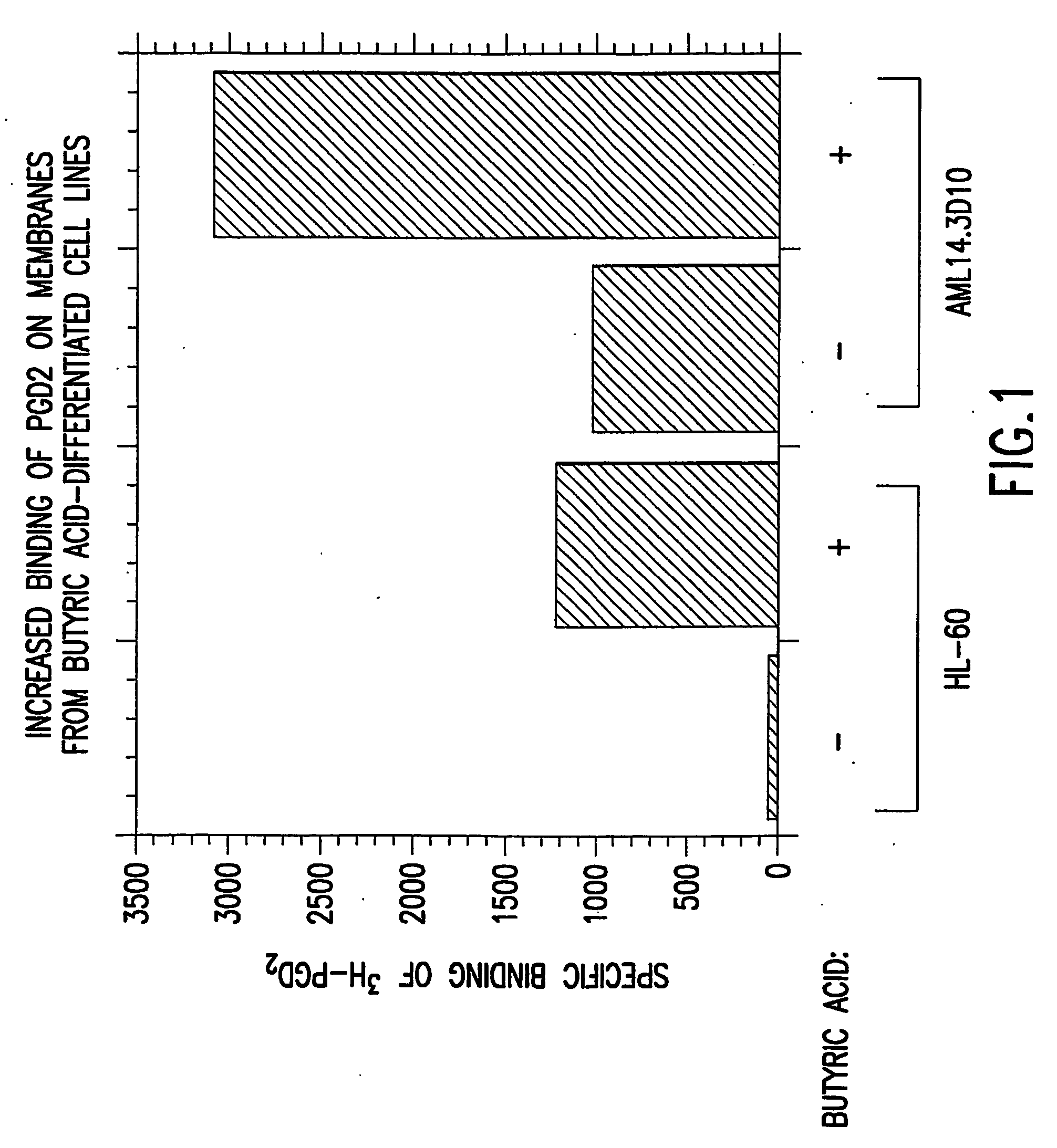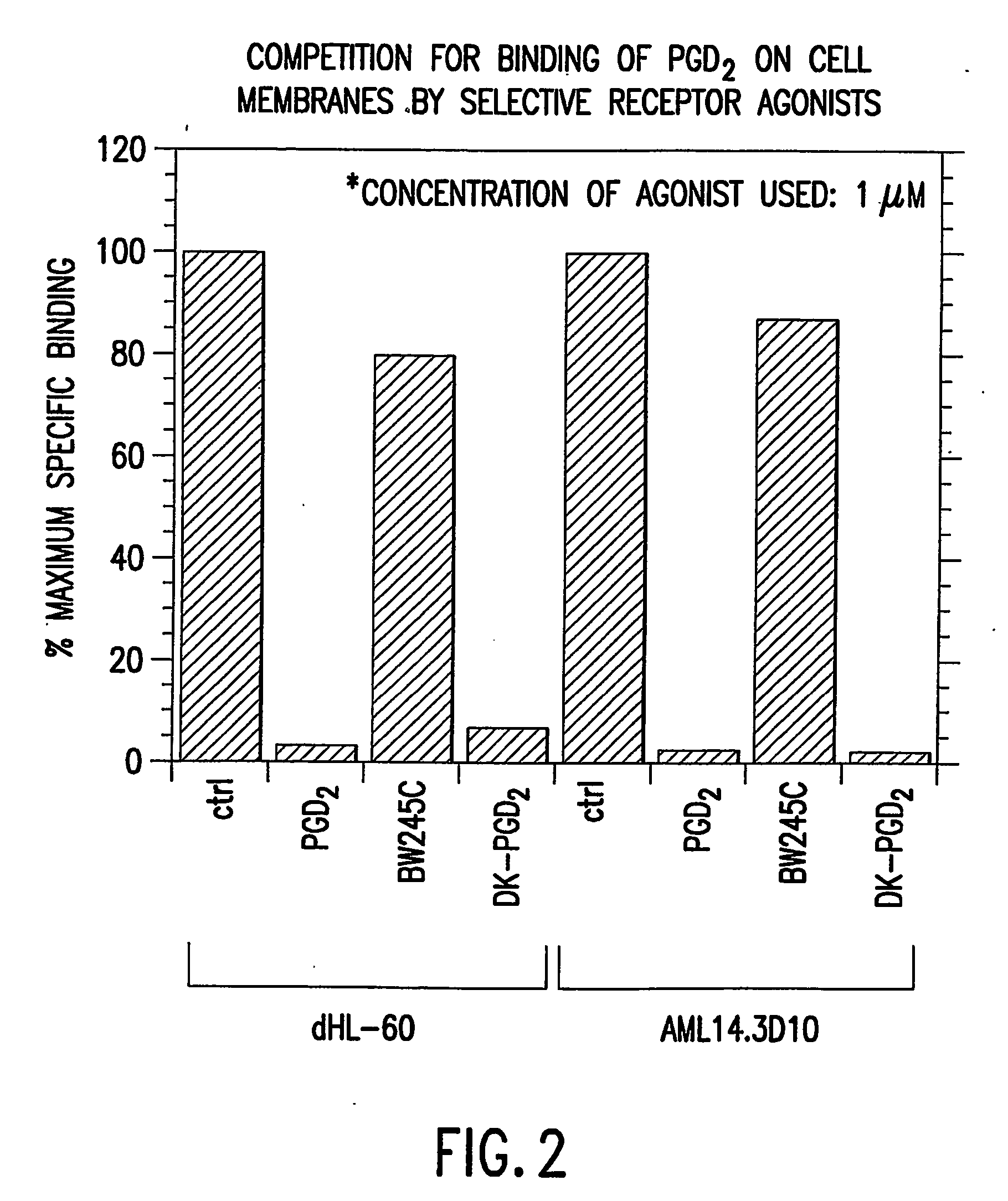Method to increase expression of pgd2 receptors and assays for identifying modulators of prostaglandin d2 receptors
a technology of prostaglandin d2 receptor and expression increase, which is applied in the field of cell lines, can solve the problems of low expression level of receptors activated by pgd.sub.2, effectively lowering the overall sensitivity of the assay, and achieves the effects of increasing camp, increasing intracellular calcium, and increasing camp
- Summary
- Abstract
- Description
- Claims
- Application Information
AI Technical Summary
Benefits of technology
Problems solved by technology
Method used
Image
Examples
example 2
[0139] Preparation of Membranes
[0140] HL-60 or AML14.3D10 cells are collected by centrifugation for 6 min at 300 g at 4.degree. C., washed with PBS, centrifuged as before and suspended in 10 mM HEPES / KOH pH 7.4, 1 mM EDTA. The cells are disrupted by nitrogen cavitation (800 psi for 30 min. on ice) in the presence of protease inhibitors (2 mM AEBSF, 10 .mu.M E-64, 100 .mu.M leupeptin and 0.05 mg / ml pepstatin). Cell membrane is isolated by differential centrifugation at 4.degree. C., first at 1000 g for 10 min then 160 000 g for 30 min. After centrifugation the pellet comprising the cell membrane is suspended in 10 mM HEPES / KOH pH 7.4, 1 mM EDTA, pH 7.4 buffer using Dounce homogenization.
example 3
[0141] Expression of CRTH2 and DP Receptors in HL-60 and AML14.3D10 Cells
[0142] There is a minimal amount of PGD.sub.2 binding on the membrane prepared from undifferentiated HL-60 cells and an appreciable level of PGD.sub.2 binding on membranes from undifferentiated AML14.3D10 cells as determined by radioligand binding assay. With butyric acid induced differentiation of cell lines HL-60 and AML14.3D10, there is a significant increase in PGD.sub.2 binding at the PGD.sub.2 receptors. About 90% of this differentiation-induced increase in PGD.sub.2 binding is competed away, in both HL-60 and AML14.3D10, by the presence of the CRTH2 selective ligand, DK-PGD.sub.2 (obtained from Cayman Chemical, Ann Arbor, Mich.). The remaining about 10% is competed away by the presence of the DP selective ligand, BW245C (obtained from Cayman Chemical, Ann Arbor, Mich.). This data demonstrates that the increase in PGD.sub.2 binding on differentiated HL-60 and AML14.3D10 is mostly due to increased expressi...
example 4
[0143] Binding Assay
[0144] Ligand binding assays provide direct methods for ascertaining receptor pharmacology and are adaptable to a high throughput format. The purified ligand for a receptor is radiolabeled to high specific activity (50-2000 Ci / mmol). A determination is made that the process of radiolabeling does not diminish the activity of the ligand towards its receptor. Assay conditions such as buffers, ions, pH and incubation time are optimized to establish a workable signal to noise ratio for both membrane and whole cell receptor assays. Such conditions are well known to one skilled in the art.
[0145] For these assays, specific receptor binding is defined as total associated radioactivity minus the radioactivity measured in the presence of an excess of unlabeled competing ligand. Where possible, more than one competing ligand is used to define residual nonspecific binding. Ligand binding assays are performed using whole cells or cell membranes derived therefrom.
[0146] a. Whol...
PUM
 Login to View More
Login to View More Abstract
Description
Claims
Application Information
 Login to View More
Login to View More - R&D
- Intellectual Property
- Life Sciences
- Materials
- Tech Scout
- Unparalleled Data Quality
- Higher Quality Content
- 60% Fewer Hallucinations
Browse by: Latest US Patents, China's latest patents, Technical Efficacy Thesaurus, Application Domain, Technology Topic, Popular Technical Reports.
© 2025 PatSnap. All rights reserved.Legal|Privacy policy|Modern Slavery Act Transparency Statement|Sitemap|About US| Contact US: help@patsnap.com


